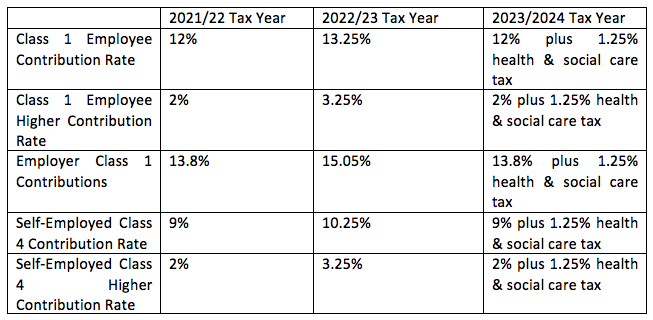Recent headlines have been dominated by the news of National Insurance increases and a new health and social care tax - but when will our contributions rise, and what does it mean for your business?
Let's recap exactly what's changing, by how much, and when.
If you need any support budgeting for tax increases or revising cash flow forecasts for the year ahead, please contact the SAS Accounting team for further assistance.
UK National Insurance Rates from April 2022
The good news is that the higher rates won't come into effect until April 2022, so there are a few months to prepare for the increase.
From April 2022:
- Self-employed and employed workers will pay an extra 1.25% National Insurance.
- Dividend taxes will increase by the same 1.25%.
- In April 2023, the rise will be replaced by the health and social care tax - this is equivalent to the same increase but will then be shown separately on payslips.
All adults in work, including employees over the State Pension age, will need to pay the social care levy, unlike other contributions, which stop once a person becomes eligible for retirement.
Why is National Insurance Increasing?
The government says that these increased taxes are to raise finances to support a massive overhaul of the adult social care system - which has crumbled under pressure from the Coronavirus pandemic.
It will also fund NHS backlogs and long-standing problems with variances in the cost of care through higher tax collections.
What that means for people in need of care is:
- From October 2023, if you have assets under £20,000, the UK government will fully fund the cost of care.
- Individuals with assets of over £20,000 but under £100,000 will receive state support, in addition to personal contributions.
- Those with assets over £100,000 (including a property) will not receive any subsidies or contributions.
- There is a new cap of £86,000, which is the maximum any person will need to finance towards their care costs.
Tax rises might be unpopular, but these changes will considerably impact older people and adults requiring social care services. For example, at the moment, if you own assets over £23,250, you need to pay all of your care costs in full.
The Impact of National Insurance Increases
Most people will want to know what this means for their take-home pay, and it's a great idea to support colleagues and staff with information so they're fully informed about the impact on their finances.
Employees pay Class 1 National Insurance Contributions, and this is where they'll see the increase.
For self-employed workers, the rise will apply to Class 4 NICs.
Businesses with PAYE workers won't need to do anything differently. The government will collect the tax through the existing system - although payslips will need to itemise the social care tax when it's introduced in 2023.
- A basic rate taxpayer earning the median average of £24,100 a year will contribute an extra £180 in 2022/2023.
- Higher rate taxpayers earning the equivalent average of £67,100 a year will pay an additional £715.
- Voluntary contributions through Class 2 or Class 3 NICs are not impacted.
The below table summarises the current contribution rates and how they will change from April 2022:
Dividend Tax Increases from 2022
We've summarised below what these changes mean for dividend tax rates in the year ahead:
Please get in touch for more support understanding how these new rates will impact your overall payroll cost or implementing changes to your pay rates to account for the additional 1.25% deduction.
SAS offers a complete range of business and personal accounting assistance to ensure you're equipped with professional guidance to make sound judgments about your financial future.




